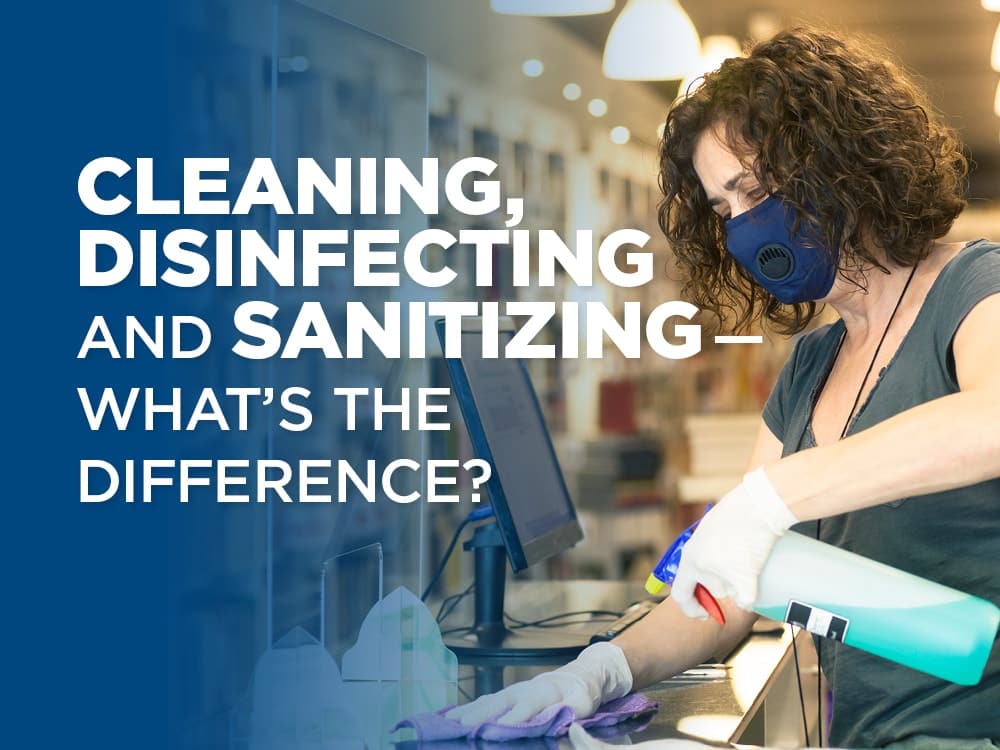- Home
- Loss Control
- Loss Control Insights
- Cleaning, Disinfecting and Sanitizing—What’s the Difference?
Words matter. While the terms cleaning, disinfecting and sanitizing are often used interchangeably, there are differences among these cleaning methods. And performing the wrong cleaning processes can cause infection spread.
Cleaning Physically Removes Dirt from Surfaces
Typically, water with added soap or detergent is used along with scrubbing. While cleaning doesn’t necessarily kill germs, bacteria or viruses, it may slow infection spread by lowering the number of germs in the area.
Additionally, cleaning to remove dust, dirt and other larger particles is an important step in both sanitizing and disinfecting surfaces and objects.
Sanitizing Helps Reduce the Growth of Bacteria
Depending on the products used, up to 95% of bacteria can be destroyed on sanitized surfaces. The sanitizing product label should include a list of types of bacteria and other germs that it can kill.
Laundry machines and dishwashers often have sanitizing cycles. And in the kitchen, surfaces that have contact with food should be sanitized.
Disinfecting Kills All Bacteria and Viruses on Hard, Nonporous Surfaces
Disinfecting properly can stop the spread of diseases like colds and influenza. Disinfecting is more effective than sanitizing in preventing disease spread. Only disinfectants approved by the EPA will kill viruses.
With the cold and flu season upon us and the ongoing COVID-19 pandemic, disinfecting is critical. Disinfecting can help us tamp down these viruses but be sure you are using an EPA-approved disinfectant.
Disinfecting Caveats
Your best course of action is to disinfect surfaces and objects while continuing to clean and sanitize appropriately.
Conduct research before choosing disinfectants and train staff thoroughly before you begin to use them. Kelsie Boorn, EMC Senior Industrial Hygienist, warns that there are caveats to watch out for. Her cautions include:
Failing to Read and Follow Instructions is Dangerous
Disinfectants can be misused and overused if not mixed and applied correctly. Kelsie recalls a recent incident where an EMC–insured business purchased a product recommended by its cleaning company.
The employees weren’t sufficiently trained on the product, which was an electrostatic spray that they had to mix.
This resulted in employees creating a spray with too high of a concentration. After it was heavily used throughout the building, employees experienced bad reactions. And cleaning the remaining spray from all surfaces was a difficult task.
Ignoring Personal Protective Equipment (PPE) is Risky
Depending on how the disinfectant is applied, gloves, face masks, boots or other protective gear may be recommended or required.
The Correct Process for Killing Bacteria and Viruses May Not be Intuitive
Unlike dirt and grime, you can’t see viruses or bacteria. Some disinfectant products may need to sit on the surface for a certain amount of time before you can use or wipe the surface. Other products may require that the surface be cleaned before application.
Following instructions for mixing and use can be the difference between successfully killing viruses and bacteria and allowing diseases to spread.
Not All Disinfectants Are Created Equal
Make sure the product is the correct one for your application. For example, a product that is safe for use around adults may not be appropriate for school use. Or one made for stainless steel may not be appropriate for fabric. Examine product labels to find the safest and best option for your job.
Mixing Chemicals Can be Deadly
While individual chemicals may not seem dangerous, when combined they can become life–threatening. Many people know that ammonia and bleach are deadly when mixed, but they might not know that bleach and vinegar are also a dangerous combo. The mixture can damage the eyes, nose, throat and nervous system.
For more information, review the steps in this EPA bulletin and best practices offered in this OSHA bulletin.
Get in touch
Need help? We’re here for you! Whether you have questions or need personalized assistance, your local office is ready to support you.
Loss Control Insights
Stay informed with the latest news and receive actionable safety tips, all carefully curated by our team of experts.
